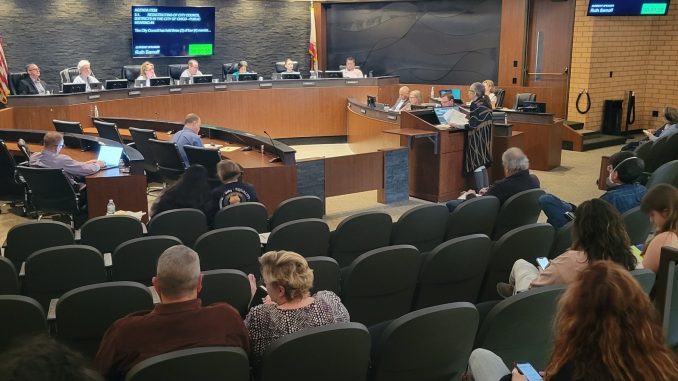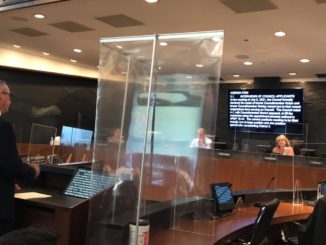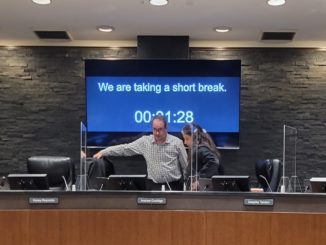
At the last regular Chico City Council meeting (March 15), when the third public hearing on redistricting drew public response even more muted than earlier in the process, council members felt anything but reassured. “Two speakers on districts?” Vice Mayor Kasey Reynolds exclaimed—and made a motion for a special meeting Tuesday night (March 29) to gather more input from residents on five maps the council culled from a dozen initial submissions.
Tuesday night, Chicoans showed up in all their passionate, politicized glory. Thirteen addressed the panel in person; 52 others emailed. Amid talk of secret identities and hidden agendas, the council advanced three modified maps to the final redistricting meeting next Tuesday (April 5).
Once again, Reynolds again made the motion—which was seconded by Councilman Sean Morgan and approved unanimously—to set as the finalists Map 5B, drawn and revised by the city’s demographer, Claudio Gallegos of ARDA Demographics; Map 6C, titled “Help People Vote,” drawn by an anonymous submitter and revised by resident Nichole Nava; and Map 2C, “Goldstein 1000,” drawn and revised by Planning Commissioner Bryce Goldstein.
The council tabled Map 4B, another demographer modification, and Map 7, “Heart of Chico,” drawn by Nava.
In explaining her reasoning to her colleagues, Reynolds said she chose from each drafter the map with the lowest deviation in population. Gallegos had explained that California’s FAIR MAPS Act has a hard-fast limit of 10 percent variation between the largest and smallest districts. Map 5B came in at 6.86, 6C at 3.13 and 2C at 4.37.
Councilwoman Alex Brown proposed going forward with just two finalists from the demographer, echoing the preliminary suggestion of Councilman Dale Bennett; her substitute motion failed to get a second. Although vocally opposed to Map 6C, Brown voted in favor of Reynolds’ motion in order to support the other two.
During deliberations, Brown asked about elements of the state redistricting law on how districts should be drawn: geographically contiguous, compact, “communities of interest” (e.g. neighborhoods) whole, boundaries following natural barriers, easily understood by residents, not politically skewed. She also inquired about the anonymous author of “Help Chico Vote”; Gallegos said the submission came unattributed from an email account of that name.
Brown told the CN&R afterward, “That public submission map should have never been considered from the outset. It’s concerning, it’s illogical, it flies in the face of many facets and guidelines of the FAIR MAPS Act … and its original author remains unidentified, unseen and unpresent, to my knowledge.
“To me, those are huge red flags, and those should be huge red flags to the people of Chico. The only legitimate maps were the demographer-submitted maps and the Goldstein maps—but I was perfectly willing to move forward with just the demographer maps for the sake of fairness across the board, going with the person we hired to create the maps.”
Though Nava reworked the original “Help Chico Vote” submission, Brown sees Map 6C as “the fruit from the poisonous tree, and I think the primary issues that I have are in the way the map was created, in its breaking up of CANA [the Avenues neighborhood] and its weird, jagged, snake-like arms that go around geographical areas of Chico, made the whole thing wonky. Fixing one part of it wasn’t going to fix the issue, which was that there was no logic to the way that map was created—and if there was, it certainly wasn’t communicated.”
Nava told the council she sought public input, including from a bus tour of neighborhoods, and consulted Chico State studies on climate change and wildfire before making her revisions. After the session, she told the CN&R she spoke with hundreds of residents, including many among those who also made comments at the meeting in favor Map 6C.
She used “Help Chico Vote” as her springboard because, even compared to her “Heart of Chico” submission, Nava said she felt it incorporated most of the preferences expressed by council members at the previous meetings. March 1, the council focused on communities of interest. March 15, along with narrowing the field, council members—Reynolds and Morgan in particular—requested modifications to consolidate residents in fire-risk zones. Though of the three remaining maps, her 6C is the only one that doesn’t keep the eastern foothill neighborhoods in one district.
“People make lots of, ‘It has to be clean’ and ‘it has to look [clear],’” Nava said. “To me, it was almost they they had to work by this perfect paint-by-numbers type of thing. That isn’t the flavor of our neighborhoods….
“It’s not the most perfectly beautiful one,” she added, “but I feel like it really did represent people.”
Those opposed to Map 6C advocated most strongly for Goldstein’s, Map 2C. A transportation planner who participated actively in the city’s initial districting for the 2020 election, she made two revisions of Goldstein 1000 and, like Nava, also submitted communities of interest for which the demographer created sets of map overlays. Seven speakers and nine emailers endorsed her map, as did the Butte County Democratic Party in a press release.
“That whole meeting was quite interesting, a little bit dramatic, but I feel the outcome was not bad,” Goldstein told the CN&R by phone the next morning. “I think they tried to please everybody [with the three finalists] … I’m glad they chose one of the maps that I created, because I created maps that are logical and based on actual communities [and] logical boundaries.
“In general, I’m cautiously OK with the results of last night…. I do think that everyone should be following this process and voicing support for maps that will serve the community—and, therefore, we’re going to need a rallying cry, because we have so many people rallying for something that they either haven’t looked at or serves their political agenda.”
Morgan, criticized in the Democrats’ press release for championing anonymous Map 6, told the CN&R that “I said from the beginning I am interested in communities of interest, one of those being the people who face the most fire danger. Let’s be clear, there’s challenges with all the maps, and also there’s no way everybody’s going to be happy, so let’s put that aside.
“The challenge here is twofold: What are the communities of interest, and let’s make sure we don’t just listen to the loudest people about what they are—and is it possible to serve them all and not break them up? The answer to the second question is no, and the answer to the first question is where do they actually lie?
“It’s not a perfect science,” he added. “And that’s why everywhere you go—every county, every city—any time districting happens, redistricting happens, everybody screams, ‘That’s gerrymandering!’ ‘I don’t like this!’ I don’t like that!’”
Because the city must file an approved map with the county clerk’s office by April 17, the council is set to finalize districts at next Tuesday’s meeting, April 6, at 6 p.m. in City Council Chambers.




Be the first to comment